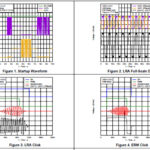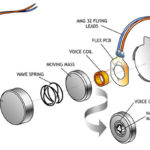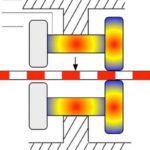Piezo haptics now can provide a realistic sensation of a click or the resistance of a pushbutton.
Sonja Taylor Brown • TDK
In the movie Ready Player One, teenager Wade Watts regularly enters a virtual reality simulator and virtual gaming environment. For citizens in this future dystopian civilization, the currency of the simulator is more stable than that of the real world, and, as a result, what happens there is more important than what happens on the outside. Wade eventually purchases a haptic suit so he can experience the physical sensation of touch from other users in the simulation.
To many engineers, good haptic technology seems as far-off as what they see in the movies. However, automobiles, gaming controllers and cell phones all use haptic technology today. And there are some misconceptions about topics that include the differences between haptic actuators and piezo benders, costs of using piezo haptic technology, customization that allows realistic feedback, and how haptics technology stands up in harsh environments.
Many users are familiar with the old-style haptic feedback on cell phone screens. Advantages of today’s haptic devices become evident from a quick review of older haptic methods. Cell phones generally have employed electromechanical haptic devices, either eccentric motors that spin an unbalanced mass to create vibrations or linear resonant actuators (LRAs) containing a spring-mounted mass that vibrates back and forth linearly. For many haptic applications like gaming, these electromechanical devices are battery hogs. They are also slow. Start-up time for an eccentric motor, defined as the time to reach 90% of the rated acceleration, is usually about 50 to 100 msec, and stopping takes a similar amount of time. LRAs tend to have slightly quicker start-up times, but applications with repeated haptic events can still have problems with LRA latency.

In contrast, today’s haptic devices are based on piezo technology and can provide a realistic sensation of a click or the resistance of a pushbutton. Devices and surfaces can be customized and miniaturized for different applications.
Additionally, piezo haptics aren’t just actuators. They can also sense pressure. Thus the devices can be set up to sense varying levels of pressure to, for example, add an element of safety in industrial settings. Here, the human-machine interface could require workers apply significant pressure to turn a system on or off so accidental “touches” don’t cause problems. On the other hand, piezo haptic actuators can be set up to register the most minute changes in movement for quick actuation of machinery where precision is imperative, as with a joystick in a forklift.
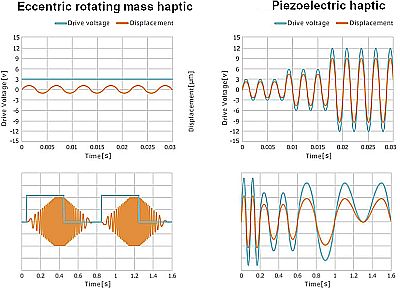
Though haptics technologies vary, it is not unusual to find them all using the same driver ICs. One example of a modern haptic driver chip is the BOS1901 from Boréas Technologies. This device provides drive voltages up to 190 Vpp working from a 3-V supply, allowing it to drive both piezo haptic actuators as well as the electromechanical haptics that require higher peak-to-peak signals. To accommodate piezo actuators that can double as sensors, the chip incorporates a high-speed SPI communication bus to allow an MCU to monitor data such as actuator voltage for sensing applications.
Despite commonalities in their drive electronics, there are differences in piezo technologies employed in haptics applications.
Piezo haptic actuator technology is not the same as piezo bender technology. This is perhaps the biggest misconception about haptic actuators. As a quick review, a piezo bimorph, or bender, operates like a bimetallic strip in a thermostat. Layers of the piezo ceramic join to either a metal substrate or to other piezo ceramic strip layers. Energizing the piezo ceramic causes a deflection that is proportional to the applied voltage. There are drawbacks to bender technology, and many suppliers of modern piezo devices feel that benders have created a negative perception of haptic technology that has been difficult to overcome. It will take time to change this perception.
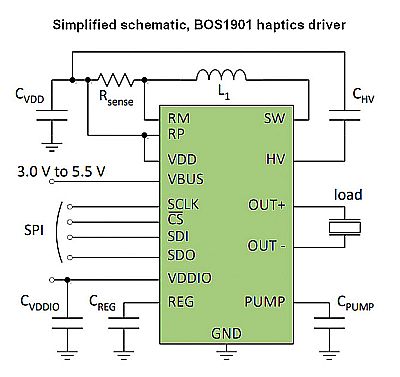
One problem with piezo benders is that they don’t stand up to vibration, shock, and other environmental conditions as well as piezo haptic actuators, which can withstand large compressive loads and deliver much larger forces and accelerations. With piezo benders the force of the load generally acts directly on both ends of the ceramic. As a result, these actuators cannot withstand large loads and can easily crack, break and fail. They also can’t provide the force and acceleration necessary for a smooth user interface, resulting in a poor user experience. This makes them impractical for many applications in industrial, mobile and automotive settings.
Now consider a piezo haptic actuator. It typically has a unimorph structure in which ceramic piezoelectric elements, having electrodes on both sides, bond to one side of a metal plate. Applying an ac voltage to the electrode expands and contracts the piezoelectric element, which warps the bonded metal plate. This unimorph structure enables the whole metal plate to vibrate with high efficiency. The resulting form factor is thinner than old style eccentric motors or LRAs. These piezo actuators also operate with drive signals of around 24 V, whereas piezo benders typically need driver voltages of 50 to 150 VPP. Piezo actuators additionally deliver tactile sensation to a wide area with a fast response, typically less than 15 msec.
There are two types of piezoelectric haptics, single-plate and multilayer. The multilayer type can generate a larger displacement than that of single-plate element of the same thickness. Such actuators can transmit a vibration sensation to the skin. Moreover, because there is no solder joint associated with connecting a wire to the element , there is no extra load from it applied to the multilayer element, thus improving the amplitude efficiency.
Because piezo haptics can be energized more quickly compared with eccentric rotating masses, the lower power consumption is also one of the advantages. As the input frequency or voltage rises, so, too, does power consumption. But it’s possible to minimize power use by judiciously managing the vibrations. Additionally, the drive voltage can serve as a means of manipulating vibration amplitude to express various, delicately controlled vibration patterns. Of course, this sort of manipulation is impossible to realize with eccentric rotating masses or LRAs where amplitude is determined by design.
Additionally, piezo haptic actuators are highly stable, reliable and rarely fail. As the primary human machine interface for many devices, they provide a good user experience – even in harsh environments. Piezo haptic actuators are robust and can give the sensation that the user has actually depressed a button. This behavior lets them serve in, for example, industrial applications such as control panels where users wear gloves. When the user touches the “button” on a control panel, the touch force can be used to trigger an actuator based on the amount force applied. Users feel this tactile feedback based on voltage, vibrations, sound and motion that gives the sensation that a button has been pushed.
It’s not fragile
The second misconception is that piezo haptic technology is expensive. Piezo haptics may cost more than LRAs or eccentric rotating mass actuators. But unlike these older technologies, they can replace switches and buttons. Because there is no need for additional holes cut into the frame, the technology becomes inherently waterproof. And a single programmable piezo haptic switch can replace several parts including sensors, buttons, ESD protection and moisture protection devices. Thanks to their high force output and compact dimensions they can take the place of several solenoid actuators while providing the same experience in AR/VR glasses.
Haptic technology can be used in a variety of applications besides AR/VR. Piezo haptic technology incorporated into automobile panels, for example, can allow the driver to “feel” the various buttons and options for selection on a menu. This sort of feedback boosts safety because it allows the driver to quickly discern one virtual button from another without having to look away from the road.
A point to note is that piezo haptic actuators can work at virtually any frequency perceptible to humans. The voltage, amplitude, frequency, duration and waveform can be tailored to produce hundreds of different kinds of feedback from a button-like click to a heavy thump. This contrasts with LRAs which must be driven only at their resonant frequency.
A third misconception is that haptic technology is fragile. This may be true of piezo benders which can break easily because the ceramic attaches directly to the movable object and a back plate. When the full external force is applied, the ceramic bends, stresses, and may eventually crack.
Piezo haptic actuators don’t operate this way. Instead of bending, they contract in the X and Y axes when excited by the driving voltage and expand in the Z direction. There is essentially no wear. In fact, piezo haptic actuators have undergone billion-cycle tests and exhibited no degradation.
Just the thing for Wade Watts’ haptic suit.

